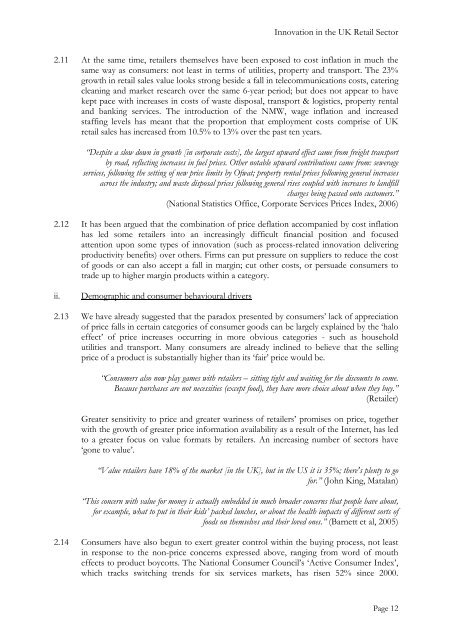Innovation in the UK Retail Sector - Nesta
Innovation in the UK Retail Sector - Nesta
Innovation in the UK Retail Sector - Nesta
Create successful ePaper yourself
Turn your PDF publications into a flip-book with our unique Google optimized e-Paper software.
<strong>Innovation</strong> <strong>in</strong> <strong>the</strong> <strong>UK</strong> <strong>Retail</strong> <strong>Sector</strong><br />
2.11 At <strong>the</strong> same time, retailers <strong>the</strong>mselves have been exposed to cost <strong>in</strong>flation <strong>in</strong> much <strong>the</strong><br />
same way as consumers: not least <strong>in</strong> terms of utilities, property and transport. The 23%<br />
growth <strong>in</strong> retail sales value looks strong beside a fall <strong>in</strong> telecommunications costs, cater<strong>in</strong>g<br />
clean<strong>in</strong>g and market research over <strong>the</strong> same 6-year period; but does not appear to have<br />
kept pace with <strong>in</strong>creases <strong>in</strong> costs of waste disposal, transport & logistics, property rental<br />
and bank<strong>in</strong>g services. The <strong>in</strong>troduction of <strong>the</strong> NMW, wage <strong>in</strong>flation and <strong>in</strong>creased<br />
staff<strong>in</strong>g levels has meant that <strong>the</strong> proportion that employment costs comprise of <strong>UK</strong><br />
retail sales has <strong>in</strong>creased from 10.5% to 13% over <strong>the</strong> past ten years.<br />
“Despite a slow down <strong>in</strong> growth [<strong>in</strong> corporate costs], <strong>the</strong> largest upward effect came from freight transport<br />
by road, reflect<strong>in</strong>g <strong>in</strong>creases <strong>in</strong> fuel prices. O<strong>the</strong>r notable upward contributions came from: sewerage<br />
services, follow<strong>in</strong>g <strong>the</strong> sett<strong>in</strong>g of new price limits by Ofwat; property rental prices follow<strong>in</strong>g general <strong>in</strong>creases<br />
across <strong>the</strong> <strong>in</strong>dustry; and waste disposal prices follow<strong>in</strong>g general rises coupled with <strong>in</strong>creases to landfill<br />
charges be<strong>in</strong>g passed onto customers.”<br />
(National Statistics Office, Corporate Services Prices Index, 2006)<br />
2.12 It has been argued that <strong>the</strong> comb<strong>in</strong>ation of price deflation accompanied by cost <strong>in</strong>flation<br />
has led some retailers <strong>in</strong>to an <strong>in</strong>creas<strong>in</strong>gly difficult f<strong>in</strong>ancial position and focused<br />
attention upon some types of <strong>in</strong>novation (such as process-related <strong>in</strong>novation deliver<strong>in</strong>g<br />
productivity benefits) over o<strong>the</strong>rs. Firms can put pressure on suppliers to reduce <strong>the</strong> cost<br />
of goods or can also accept a fall <strong>in</strong> marg<strong>in</strong>; cut o<strong>the</strong>r costs, or persuade consumers to<br />
trade up to higher marg<strong>in</strong> products with<strong>in</strong> a category.<br />
ii. Demographic and consumer behavioural drivers<br />
2.13 We have already suggested that <strong>the</strong> paradox presented by consumers’ lack of appreciation<br />
of price falls <strong>in</strong> certa<strong>in</strong> categories of consumer goods can be largely expla<strong>in</strong>ed by <strong>the</strong> ‘halo<br />
effect’ of price <strong>in</strong>creases occurr<strong>in</strong>g <strong>in</strong> more obvious categories - such as household<br />
utilities and transport. Many consumers are already <strong>in</strong>cl<strong>in</strong>ed to believe that <strong>the</strong> sell<strong>in</strong>g<br />
price of a product is substantially higher than its ‘fair’ price would be.<br />
“Consumers also now play games with retailers – sitt<strong>in</strong>g tight and wait<strong>in</strong>g for <strong>the</strong> discounts to come.<br />
Because purchases are not necessities (except food), <strong>the</strong>y have more choice about when <strong>the</strong>y buy.”<br />
(<strong>Retail</strong>er)<br />
Greater sensitivity to price and greater war<strong>in</strong>ess of retailers’ promises on price, toge<strong>the</strong>r<br />
with <strong>the</strong> growth of greater price <strong>in</strong>formation availability as a result of <strong>the</strong> Internet, has led<br />
to a greater focus on value formats by retailers. An <strong>in</strong>creas<strong>in</strong>g number of sectors have<br />
‘gone to value’.<br />
“Value retailers have 18% of <strong>the</strong> market [<strong>in</strong> <strong>the</strong> <strong>UK</strong>], but <strong>in</strong> <strong>the</strong> US it is 35%; <strong>the</strong>re's plenty to go<br />
for.” (John K<strong>in</strong>g, Matalan)<br />
“This concern with value for money is actually embedded <strong>in</strong> much broader concerns that people have about,<br />
for example, what to put <strong>in</strong> <strong>the</strong>ir kids’ packed lunches, or about <strong>the</strong> health impacts of different sorts of<br />
foods on <strong>the</strong>mselves and <strong>the</strong>ir loved ones.” (Barnett et al, 2005)<br />
2.14 Consumers have also begun to exert greater control with<strong>in</strong> <strong>the</strong> buy<strong>in</strong>g process, not least<br />
<strong>in</strong> response to <strong>the</strong> non-price concerns expressed above, rang<strong>in</strong>g from word of mouth<br />
effects to product boycotts. The National Consumer Council’s ‘Active Consumer Index’,<br />
which tracks switch<strong>in</strong>g trends for six services markets, has risen 52% s<strong>in</strong>ce 2000.<br />
Page 12







